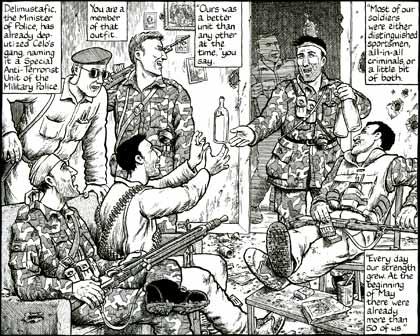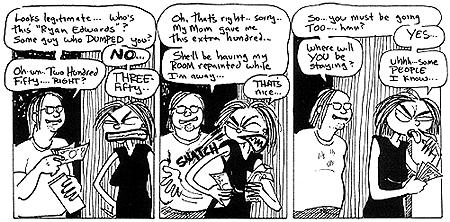Unlike traditional journalism, literary journalism deals with facts to create a lasting meaning from the narrated events. Its purpose is not only the transmission of information but the telling of a story with an awareness that the how is as important as the what.

Literary journalism's emphasis on the story and on the ideas and emotions conveyed by it relates directly to what some comics have been doing in recent years. Rising out of the underground and independent comics scene, “comics journalism” combines the structural conventions of the traditional comic book with those of literary journalism.
Like literary journalism, comics journalism has to deal with delay between the time of an event and the time of publication. “News” journalism relies on speed, but creating comics journalism requires even longer than it takes to do literary journalism. Nevertheless, a tradition of non-fiction comics exists, and recent graphic narratives are offering innovative ways of telling stories about real events.
From superheroes to “loserdom”
The “graphic novel” exists as a category in most Western book shops, libraries and web sites, even if the name evokes a vagueness comics scholars have yet to clarify. For now, the graphic novel enjoys more prestige than the comic book, which retains an aura of narrative immaturity and low-brow geekiness. It also has decidedly more status than the comic strips fated to help sell moribund newspapers—gag-structured tales doomed to be read in a flash and forgotten.
Contemporary non-fiction comics reflect the heritage of the underground “comix” of the late 1960s and 1970s. Born as an alternative to the commercially-driven superhero tales addressed to a teenage audience, the works of Harvey Kurtzman, Robert Crumb and Harvey Pekar helped define the potential of comics to tell stories based on real events.
In the 1980s and early 1990s Art Spiegelman would draw the masterstroke with his two-tome Pulitzer-winning Maus: A Survivor's Tale, a memoir telling the story of Spiegelman's relationship with both his father, a Holocaust survivor, and his father's testimony. Written and drawn over thirteen years, Maus demonstrates comic books' ability to narrate the most serious of subject matters, marking a kind of coming of age in the cultural sphere.
The 1990s were also the age of the autobiographic comic story, long narratives focusing on the existential angst of the personal lives of their mostly-young authors. Promoted by independent publishers with an awareness of the importance of sophisticated book design, these stories addressed a reader other than the typical superhero “fanboy.”
D.B. Dowd defined these comics of the early and mid 90s as “an illustrated literature of loserdom.” But beyond their self-absorption and fictional self-awareness, the works of Daniel Clowes, Peter Bagge, Roberta Gregory, and Debbie Drechsler explored comics as a way of narrating real life through the distortion inherent in cartooning.

In the mainstream popular imagination, comics were a language used to express a fictional reality as impossible as the powers of superheroes. In the hands of these new authors, the examined real life became the main focus of the stories. This tension between real subjects and a highly manipulated form of representing them remains one of the most fascinating aspects of graphic storytelling.
Surely the written word filters “reality” as well. But how is it that cartoons, which evoke such a sense of distance between subjects and their representation, can address real events and people in truthful, thought-provoking ways?
[Part 2 continues the story of comic book news with a look at the turn toward graphic narrative nonfiction.]
Ernesto Priego is researching comics and narrative as a Ph.D. candidate in information studies in the U.K. at University College London.


